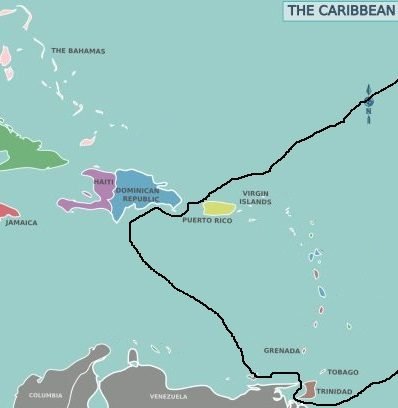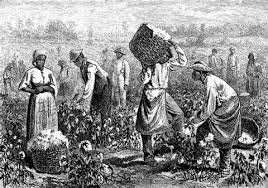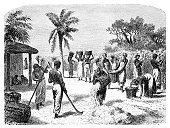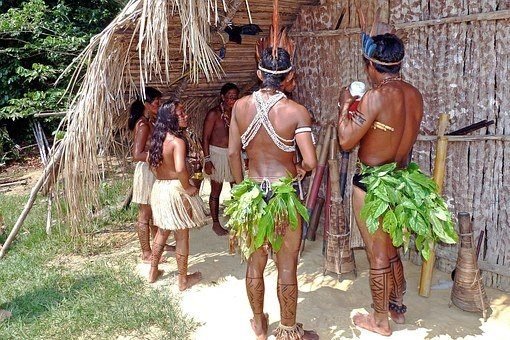Summary

Definition of Culture
Culture is the way of life of a people. It includes the social behaviour and norms found in a human society. It also includes the knowledge, beliefs, arts, laws, festivals and customs, foods, clothes, music, capabilities, and habits of the individuals in these groups.
Social behaviour is how we interact with each other. The actions of one person could affect another.
Norm refers to acceptable ways of conduct within groups.
Culture in Trinidad and Tobago
Trinidad and Tobago is multi-cultural, multi-racial, and multi-religious. It can be considered multi-lingual to an extent because of the many different representation of immigrants here who have migrated from another country. With this mixture, we have seen a mixing of cultures and the formation of new cultures.
The following are are an account of the different people that give Trinidad and Tobago its identify.
First, study the map in this link to help you understand where the different people came from.
The Past with Indigenous People
Christopher Columbus, an Italian explorer and navigator, began his expedition to the New World in 1492; sponsored by Queen Isabella I and King Ferdinand II of Spain. He hoped this journey would get him another route to the East Indies and thus profit from the lucrative spice trade of that time.
Christopher Columbus again came in contact with the native Amerindians on his third voyage to the New World in 1498. With three ships – Santa Clara (Niña), la Pinta and la Santa Gallega (Santa Maria) – he explored the south of the Caribbean island. The ships arrived at South America and he sighted the land of Trinidad on 31 July.

The fleet sailed along the southern coast and encounted the Dragon’s Mouth, anchoring near Soldado Rock where they made contact with a group of native Amerindians in canoes. On the 2nd August he landed on Icacos Point (he called Punta de Arenal). His “discovery” began the colonization of the Americas, including Trinidad and Tobago.

The Island of Trinidad (called Iere or Kairi by the Amerindans) was already inhabited by Amerindian tribes, at most for past 6000 years. These Amerindians were the first set of people to settle on our land, and may have come from the mainland of South America. They were referred to as the Caribs (Kalinagos) and Arawaks (Taino).
The Arawakan tribes had settled communities that were based on agriculture. Their culture was well-developed. Unlike the Caribans who were more nomadic. They tended to raid other tribes and so they were known to be fierce and warlike.


The Native Amerindians communities were governed by a Cacique or Chief. They made canoes to get around on water; and bow and arrows or blowguns to protect themselves or to hunt for food. They lived in an ajoupa and ate cassava bread, farine, barbecued wild game, corn pastelle, coffee, and chadon beni.
The native Amerindians did not wear much clothing and were barefooted. The Arawak men wore decorative loincloths and cloaks, while the Arawak women wore short skirts and strands of shell necklaces. Their hair, sometimes long, were decorated with colorful parrot feathers or crowns of flowers for festive occasions. They often painted their faces and bodies in bright colors, especially for battle or festivals.


Their contact with the Europeans were devastating. Many of the Amerindians died from slavery, general hardship, warfare, or epidemics (small pox and cholera). They were displaced many times and in 1759, the Mission of Arima was formed and in 1785 they were given control of 2000 acres of land. That was the last Mission Town in Trinidad.
The Amerindians in Trinidad converted to Catholicism. The Amerindians have given us two festivals: the Santa Rosa Festival (Arima) and the La Divina Pastora (Siparia). They sang parang, a music style that utilize both Spanish and Amerindian musical instruments.
Amerindian words and names that survive to present day are
- Place : Caroni and Oropouche Rivers, Tamana and Aripo mountains, Arima, Paria, Arouca, Caura, Tunapuna, Tacarigua, Couva, Mucurapo, Chaguanas, Carapichaima, Guaico, Mayaro, Guayaguayare,
- Flora: cassava, maize, cacao, tobacco,
- Fauna: manicou, agouti
The Amerindians are enslaved by the Spanish
The Amerindians became the first slaves for the Europeans. The island was appointed a governor in 1530 and settlements soon follow. The Spanish settled in Mucurapo, St, Joseph (originally called San José de Oruña) , San Fernando, Rio Claro, Barataria, El dorado, Palo Seco, Santa Cruz, and Vista Bella. By 1772, the population had increased and comprised of 326 Spaniards and 417 Amerindians. The island lack the gold the colonizers wanted and it was thus poor and undeveloped.
Spanish missions were established as part of the Spanish colonization. Capuchin friars were given responsibility for the conversion of the indigenous population of Trinidad. Missions were formed, such as in Princes Town, San Fernando, Santa Rosa de Arima, Caura, and Arouca. Most of the missions were closed and the occupants in the missions were relocated. Most settled in Santa Rosa close to the town of Arima.
Tension between the priest and Amerindians led to the Arena Massacre of 1699, wherein the Amerindians murdered the priests. The Spanish responded and many Amerindians died. By 1777, The population as recorded was 2,763 living on the island, including some 2,000 Arawaks.
The Cedula of Population was granted by the Spanish crown as an incentive to lure settlers to the island.
The French Community and Enslaved Africans
The French planters, first settlers following the Cedula of Population, arrived on the island and they bought with them African slaves. It is estimated 1,532 whites and 33,322 slaves. The new settlers were granted acres of land. They migrated during the French revolution.

These migrants established communities at Blanchisseuse, Champs Fleurs, Paramin, Cascade, St. Claire, Petit Bourg, Point-a-Pierre, Grand Riviere, Carenage, and Laventille. By the time the island was surrendered to the British in 1797, the population had increased to 17,643: 2,086 whites; 4,466 free people of colour; 1,082 Amerindians, and 10,009 African slaves. In addition, there were sugar estates, coffee estates, cocoa estates, and cotton estates. The African slaves were brought to work on the plantations. The island was unfortified. Much different from Tobago.
In Tobago, the settlers came from Europe over the years. The first Fort set up by the British was Fort Vissingen (Fort Flushing) near Plymouth in 1628. Then the Dutch had three forts. The Frenchmen had their own settlement. By 1659, the island of Tobago was populated with 1,500 Europeans, about 7,000 African slaves working on 120 plantations. It was supported by six or seven sugar mills and two rum distilleries. The island changed hands several times.
By 1793, the island was again recaptured by Britain. The population on the island by 1791 was 15,020. Of which 541 were white and 14,170 were slaves. There were sugar, cotton and coffee factories, and a nutmeg plantation.
Trinidad Becomes a British Crown Colony
By 1797, Trinidad was invaded by the General Sir Ralph Abercromby and the island became a British crown colony, with French-speaking population and Spanish laws. The British rule was formalized and rule led to the influx of settlers from the United Kingdom and British colonies of Eastern Caribbean. English, Scots, Irish, German and Italian families arrived. They settled in Brighton, Edinburgh, Palmiste, Waterloo, Hamony Hall and Union Hall.

New estates were created and the import of slaves did increase, but this was the period of abolition in England. Slavery was abolished in 1833 after which former slaves served an apprenticeship period and was to be ended by 1840. However, a non-violent protest and passive resistance to the time of apprenticeship helped to end it earlier. Full emancipation was granted on 1 august, 1838. Tobago in 20 Oct, 1898, became a ward of Trinidad.
The Venezuelan Farmers on Cocoa Estates
In the 19th century there were more sugarcane plantations and an increasing cultivation of cacao. Chocolate became a high-priced sought after commodity. So, Venezuelan farmers, experienced in cacao cultivation, provided much of the early labour in these estates. The descendants of these workers stayed in these areas. They were referred to as the cocoa panyols ( short for espagnol).
The Portuguese
The Portuguese appeared in Trinidad in the 17th and 18th century. They supplied the colonies with slaves by Portuguese traders. However, in was in the 1850s, when the first set of refugees fled the island of Madeira. They were Protestant. They were given work as drivers, overseers and shop managers on the estates. As for the shops, the goods they supplied to the labourers on the estate were expensive as their wage averaged 20 cents a day. The shops made huge profits and kept the labours in debt to the estate. This was the new freedom as “wage slavery replaced the chattel of slavery” that existed in the pre-emancipation days (source). The government at the time had to legislate against the estate owners. Soon the Portuguese were able to gain complete control of the grocery, liquor and small shop trade of the island. They were successful because they mix freely with the population.
Workers from the East
Workers were also brought from China the same time to work on the estates. However, by the 1900, they were mostly shopkeepers, as well as general merchants, miners and railway builders.
Workers were also brought from India (first in 1845). Many Indian immigrants came as indentured labours to work on the sugar estates. Over time, the Indian community has steadily prospered and grew.

When the cacao trees were affected by the witches’ broom and black pod disease and the Great Depression in the 1930s, the industry began its decline. Relations between the Indian immigrants, British and Black population were strained and occasionally erupted in violence.
Activity
You may need help for this activity. Make your own Fatel Razack boat.
You will need:
- 3 light coloured paper (for the sails)
- paper roll and foam
- long juice carton, cut side ways form the bottom and sides of the boat.
- 3 long drinking straws or wooden skewers
- clear or coloured tape or strong glue
- single-hole paper punch
- scissors
Direction:
Step 1. Cut the light coloured paper to make the sails. Punch holes on the sale so the straw and stick can go through two ends. Send the straw or the stick through. The stick or straw should not slip out easily.
Step2. Cut the carton to make the boat. On the paper roll, make three holes equally spaced. Fill the roll with the foam and fasten the roll to the boat. (Note: make sure the roll is a bit smaller than the boat.)
Step 3.Place the sticks with sail into each old of the log. Secure the straw or stick. Colour your boat and test it out.
The Syrian/Lebanese Immigrants
At the turn of the 20th Century, a handful of settlers came from the Greater Syria and the coastal towns of Lebanon. They were young Christian men and women in search of better fortune rather than stay under an oppressive Muslim government. Before World War 1, there were less than 100 syrians and Lebanese in Trinidad. The community they formed here strived as entrepreneurs.
They settled in east Port of Spain and found it easy to integrate with the Roman Catholics of Trinidad. They came at a time when the cocoa economy was booming, and sugar plantation was striving. The middle class and upper echelon were growing. At that time the “Magnificent Seven” was built. The Syrian and Lebanese community was the last ethnic group to have come to Trinidad in the 20th century.
Trinidad in the early 20th century
Here are some videos of life in the early 20th century in Trinidad.
Trinidad, 1943
Port of Spain in the 1950s
Village Life in the 1950’s
Contributions of the People Who Came
The Trinidad and Tobago society is made up of many cultures, races and religions. Many aspects of that made up the society in the past also make up society today. However, in other cases there have been a mixing of cultures. This helped Trinidad and Tobago gain its own identity.
The Amerindian
- Food – cassava, maize, tobacco, farine, sweet potato
- Music – chac-chac, drums, whistles
- Religion – nature worshippers
- Furniture – hammocks
- Names for animals – agouti, manicou
- Names of places – Caroni, Arima, Couva, Chaguanas, Toco, Mayaro
The Spanish
- Food – pastelles, arepas
- Song – parang
- Dance – joropo, castillian, bolera
- Music – guitar, cuatro
- Religion – Roman Catholic
- Names of places – San Fernando, santa Cruz, Barataria, San Juan, maracas, Esperanza, Rio Claro
The British
- Food – many baked and broiled dishes
- Clothing – dresses, suits
- Religion – Anglican
- Language – English
- Names of Places – Palmiste, Waterloo, Harmony Hall, Brighton, Edinburgh, Perseverance, Mount Pleasant
The French
- Culture – Carnival
- Language – French (Patois)
- Religion – Roman Catholic
- Names of places – Pointe-a-Piere, Champ Fleur, Grand Riviere
- Names of People – Martineau, Piere, La fleur, La Guerre, La Borde
The African
- Food – coo-coo, callaloo, chilli bibbi, accra, pemi
- Religion – The Orisha, Shango
- Music – drums, bells, rattles
- Dance – limbo, bongo, shango
- Names of places – Sobo (La Brea, South Trinidad); mandingo Village, Sierra Leone Road
- Folklore – Moko Jumbie, Midnight robbers, Soucoyant, duoen
- Method of helping others – Gayap
- Savings – sou-sou
The Chinese
- food – chow mein, wanton soup, fried rice
- Clothing – pinfu, changpao, shenyi, cheiongsham
- Religion – Taoism, Buddhism, Confucianism
- Language – Mandarin
- Names of places – Cococrite
The East Indian
- Food – roti, parsad, spices, curried dishes
- clothers- sari, shalwar, kurta
- religion – Hinduism, Islam
- Custom – Henna-art, weddings, funerals
- Musical instruments – sitar, chowtai, tassa
- Dance – Classical Indian dance
- Names of places – Bejucai, barrackpore, Calcutta, Fyzabad, Hinustan, madras Settlement
- Names of People – Kamla, Basmatie, Persad, Maharaj, Hosein, Khan
The Portuguese and the Syrian
- Business and Entrepreneurship
Worksheets
Click the links below to download the PDF worksheets.
Contributions – Indentured Labourers
Quiz- Our Ancestors and their Contributions



